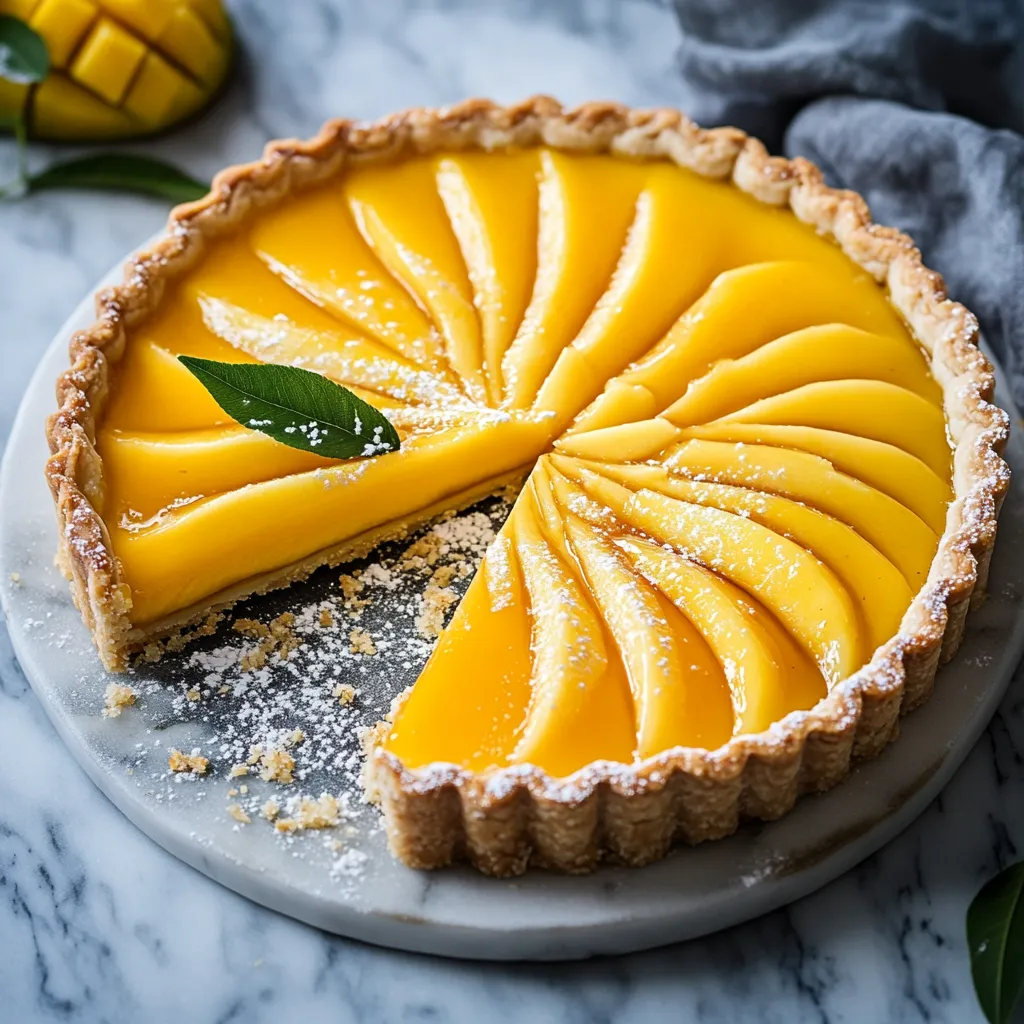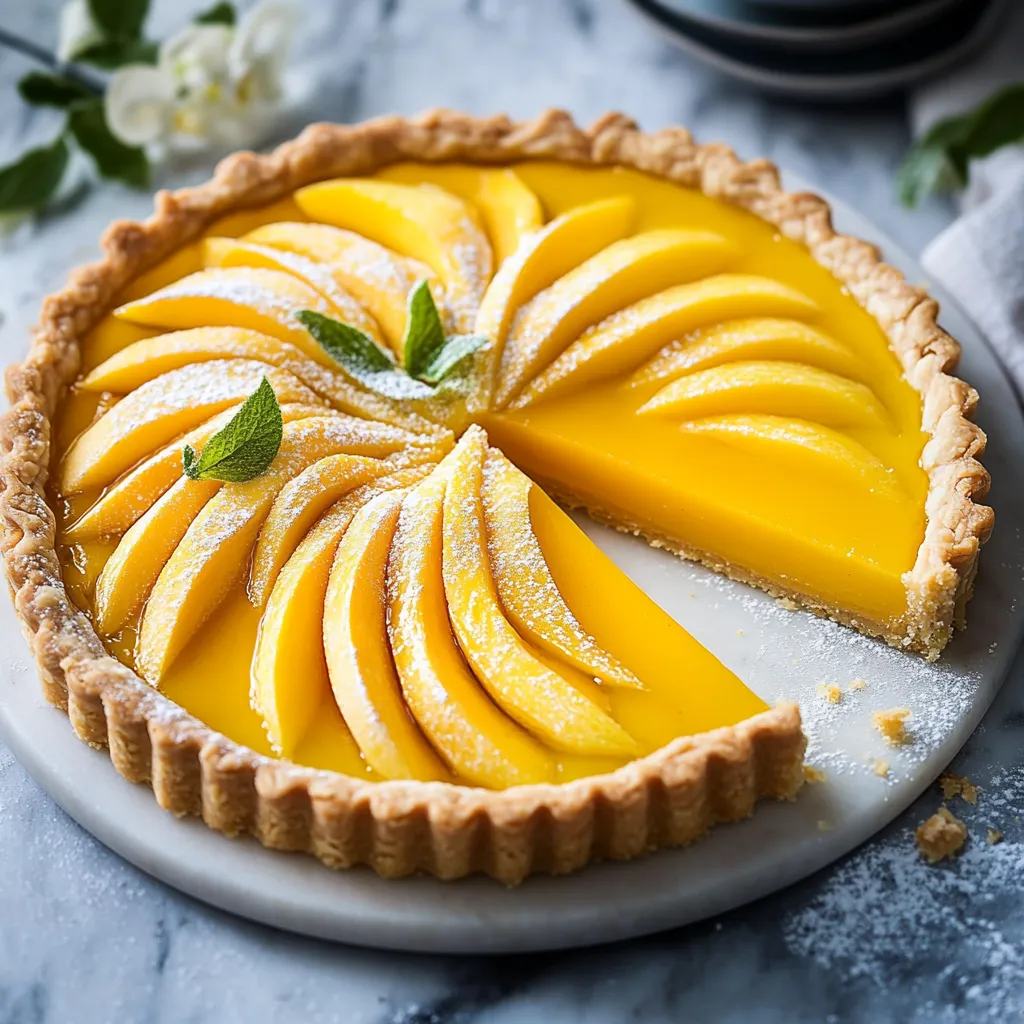 Pin it
Pin it
This mango curd tart brings the tropical sunshine to your table with its vibrant color and bright flavors. The luscious mango filling nestled in a coconut graham cracker crust creates the perfect balance of sweet, tangy, and buttery textures that will transport you to an island paradise.
I first made this tart for a summer dinner party when fresh mangoes weren't at their peak. My guests were so impressed they thought I had ordered it from a bakery. Now it's my signature dessert whenever I want to bring a touch of the tropics to any occasion.
Ingredients
- Graham cracker crumbs: Form the foundation of our flavorful crust, look for honey graham crackers for the best flavor
- Kosher salt: Enhances all the flavors and balances the sweetness in both crust and filling
- Brown sugar: Adds depth to the crust with its molasses notes
- Toasted coconut: Brings tropical flavor and wonderful texture to the crust
- Unsalted butter: Binds the crust and adds richness throughout the recipe
- Canned mango puree: Provides consistent flavor and texture, Kesar variety offers the most authentic mango flavor
- Vanilla extract: Rounds out the tropical flavors
- Granulated sugar: Sweetens the curd without overpowering the mango
- Lime zest and juice: Provide essential acidity to balance the sweet mango
- Egg yolks: Create the silky texture and help the curd set properly
- Swiss meringue: Adds a beautiful finishing touch that can be lightly toasted for drama
- Fresh mango slices: Showcase the star ingredient in its natural form
Step-by-Step Instructions
- Prepare the oven:
- Heat your oven to exactly 350°F which ensures the crust bakes evenly without burning the coconut. Use an oven thermometer if you have one as many ovens run hot or cold.
- Create the crust mixture:
- Combine the graham cracker crumbs, salt, brown sugar, and toasted coconut in a medium bowl, mixing thoroughly to distribute the ingredients evenly. Pour in the melted butter and stir until every crumb is moistened and the mixture resembles wet sand.
- Form the perfect crust:
- Transfer the crumb mixture to your tart pan, starting by pressing the mixture firmly into the bottom using the flat bottom of a measuring cup or glass. Work your way up the sides, using your fingers to create an even thickness throughout. The crust should be about ¼-inch thick with a clean edge at the top.
- Bake the foundation:
- Place the tart pan on a baking sheet before putting it in the oven. Bake for exactly 10 minutes until just starting to turn golden and fragrant. The crust will still be soft but will firm up as it cools.
- Create the mango curd base:
- Reduce your oven temperature to 325°F. In a heatproof bowl, whisk together the mango puree, lime zest, lime juice, vanilla extract, granulated sugar, salt, and egg yolks until completely smooth. The mixture should be bright orange and free of any lumps.
- Cook the curd properly:
- Create a double boiler by placing your bowl over a pot of simmering water, making sure the bowl doesn’t touch the water. Whisk constantly for about 20 minutes until the curd coats the back of a spoon and leaves a clear path when you run your finger through it. The temperature should reach 170°F on an instant-read thermometer.
- Incorporate butter for richness:
- Remove the curd from heat and add the butter in small pieces, whisking after each addition until completely melted and incorporated. Strain through a fine-mesh sieve if you notice any cooked egg bits or lime zest pieces for the smoothest texture.
- Bake to perfection:
- Pour the warm curd into the cooled crust, using an offset spatula to spread it into an even layer. Tap the pan gently on the counter to remove any air bubbles. Bake for 15-17 minutes until the edges are set but the center still has a slight jiggle like firm gelatin.
- Chill for best texture:
- Allow the tart to cool completely at room temperature, then refrigerate for at least 4 hours or preferably overnight. The extended chilling time allows the flavors to meld and the curd to set properly for clean slices.
 Pin it
Pin it
Kesar mango puree is my secret weapon in this recipe. After trying multiple varieties, I found this particular type offers the most vibrant color and authentic mango flavor. My grandmother, who grew up in India, took one bite and declared it tasted just like the mangoes from her childhood garden.
Storing Your Mango Tart
This tart keeps beautifully in the refrigerator for up to five days when stored in an airtight container. The flavor actually improves after the first day as the crust and filling have time to meld together. For the best presentation, add any fresh garnishes just before serving rather than in advance.
Smart Substitutions
If you cannot find canned mango puree, you can make your own by pureeing fresh, ripe mangoes and cooking them down until thick. For a dairy-free version, substitute coconut oil for butter in both the crust and filling. The lime can be replaced with lemon for a different but equally delicious citrus note.
Serving Suggestions
Serve this tart chilled but not ice-cold to fully appreciate the flavors. A dollop of lightly sweetened whipped cream or crème fraîche makes a wonderful accompaniment if you skip the meringue. For a dinner party, pair small slices with a glass of late-harvest Riesling or passion fruit cocktail to complement the tropical notes.
The History Behind the Tart
Fruit curds originated in England in the late 19th century, with lemon being the traditional choice. This mango adaptation brings together British technique with tropical flavors. Mango desserts have been popular in Indian, Thai, and Filipino cuisines for centuries, but combining mango with the Western tart format creates a perfect fusion dessert that honors multiple culinary traditions.
 Pin it
Pin it
Frequently Asked Questions
- → What type of mango puree works best?
Kesar mango pulp is highly recommended for its rich flavor and natural sweetness. You can also use any smooth canned mango puree.
- → Can I use a different crust instead of graham crackers?
Yes, you can substitute the graham cracker crust with a traditional tart crust or even digestive biscuits for a similar texture.
- → How do I know when the mango curd is cooked properly?
The mango curd is ready when it thickens and can coat the back of a spoon. It should not be runny or overly stiff.
- → What if I don’t have a tart pan?
A pie pan or springform pan can be used as an alternative to create a similar shape.
- → How long should I chill the tart before serving?
For optimal flavor and texture, chill the tart for at least 4 hours or overnight before serving.
